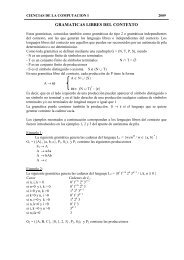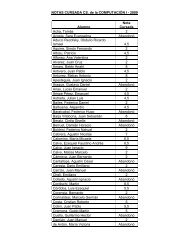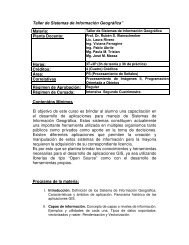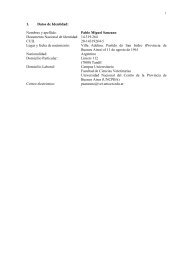Libro de Resúmenes / Book of Abstracts (Español/English)
Libro de Resúmenes / Book of Abstracts (Español/English)
Libro de Resúmenes / Book of Abstracts (Español/English)
You also want an ePaper? Increase the reach of your titles
YUMPU automatically turns print PDFs into web optimized ePapers that Google loves.
Resumenes 89<br />
A(H3N2). Starting in Vietnam, with the first proved case, with similar<br />
symptoms to the usual flu and an incubation period <strong>of</strong> 3 days, characterized<br />
for having get in contact with infected birds, or with its secretions, with the<br />
very same virus. The birds have their natural reservoirs and they can infect<br />
humans, at this time, they are rare cases and until now, humans can't infect<br />
humans. Nevertheless, helped by the common scientific rigour <strong>of</strong> the<br />
doctors and veterinarians, we can conclu<strong>de</strong> that given the persistence <strong>of</strong> the<br />
H5N1 flu since 1997, the genetic changes that allow the humans to get<br />
infected by themselves, in the same subtype virus (H5N1) is imminent.<br />
That's the reason why the WHO let out an international alert.<br />
In this paper a Mathematical Mo<strong>de</strong>l is proposed to study the H5N1<br />
Aviar Flu in two stages: The fisrt one is formed by a fenomenological mo<strong>de</strong>l<br />
<strong>of</strong> the H5N1 flu, which has as its unique variable the passed time τ since the<br />
moment when the succeptible one is infected by the pathogenical agent.<br />
This mo<strong>de</strong>l comes to a single system <strong>of</strong> ordinary differential equation that<br />
AIDS to estimate some <strong>of</strong> the parameters. The second stage consists in the<br />
very mathematical mo<strong>de</strong>l, posed with the passed time (t) <strong>of</strong> the epi<strong>de</strong>mics<br />
itself, as well as the τ; time, that we had introduced already. The overall<br />
result is a system <strong>of</strong> integral-differential equations way much more<br />
complicated than the first one. The scientific analogy is achieved by the use<br />
<strong>of</strong> the Continuum Mechanics. This result lies in the analysis <strong>of</strong> two extreme<br />
scenarios: the former corresponds to a very-controled-in-time epi<strong>de</strong>mics,<br />
which is a stage where it doesn't happen nothing extraordinary and the<br />
people involved can be counted only by hundreds, meanwhile the latter is<br />
catastrophic and the numbers we <strong>de</strong>al with are counted by thousands, even<br />
millions, <strong>de</strong>pending on the population size. Even this stage is not very<br />
likely, it would mainly correspond to a non-controlled epi<strong>de</strong>mic with an<br />
important <strong>de</strong>tection <strong>de</strong>lay.<br />
Referencias<br />
• http://www.who.int/csr/disease/avian_influenza/en<br />
• Alvarado <strong>de</strong> la BC, Reyes TG; Comunicación personal; Influenza: Forecast<br />
for an epi<strong>de</strong>mia,...En prensa.<br />
• Responding to the avian influenza pan<strong>de</strong>mic threat; WHO /CDS /GIP /2005.8<br />
http://www.who.int/csr/disease/avian_influenza/gui<strong>de</strong>lines/globalsurveillanc<br />
e/en<br />
• Avian influenza: assessing the pan<strong>de</strong>mic threat; WHO /CDS /GIP /2005.29<br />
http://www.who.int/csr/resources/publications/influenza /WHO _CDS _CSR<br />
_NCS _2002.5/en<br />
• Gómez AG, "Mo<strong>de</strong>lo Matemático <strong>de</strong>l SARS para la Ciudad <strong>de</strong> México", 2003,<br />
Foro-Red-Mat:, 2003 , Vol. 13, No.5, 1-20; http://www.red-mat.unam .mx<br />
/~foro (conjunto con , Boyev BV)



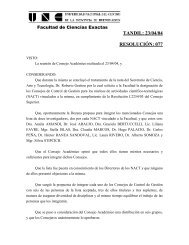
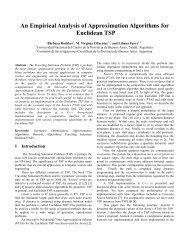
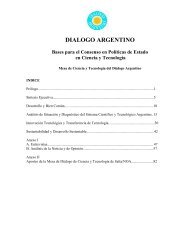
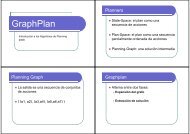
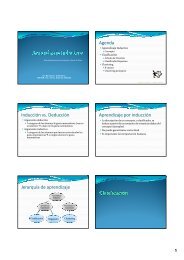
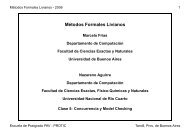
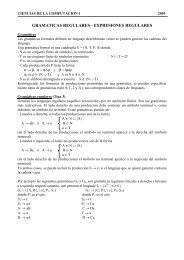

![Clase 13 [pdf]](https://img.yumpu.com/19616969/1/190x245/clase-13-pdf.jpg?quality=85)

